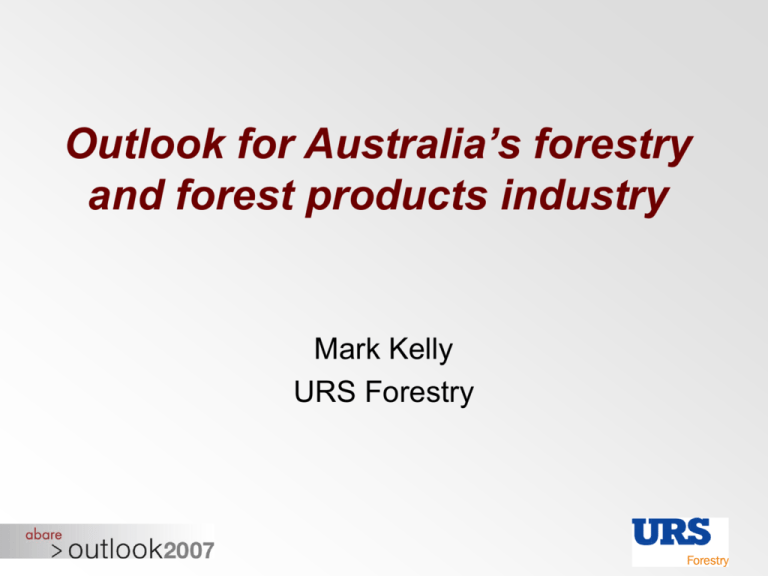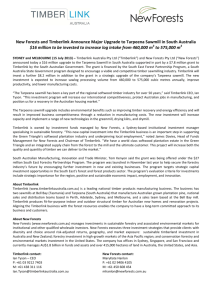Outlook for Australia's forestry and forest products industry
advertisement

Outlook for Australia’s forestry
and forest products industry
Mark Kelly
URS Forestry
Outline of issues
•
•
•
•
•
•
•
•
International context
Resource trends and log markets
Sawn timber
Pulp and paper
Export woodchips
Composite boards
Emerging products
Conclusions
International overview
• China’s demand and production driving
international wood product markets
• Declining native tropical forests
• Increasing supplies from plantations
• Supplies from Russian forests
• South American pulp and paper expansion
China’s demand and log prices
Softwood log imports
Hardwood log imports
25
14
12
20
Million cu mt
Million cu mt
10
8
6
15
10
4
5
2
350
Australia
United States
Myanmar
2004
2003
2002
2001
2000
1998
1999
Russia
Other
120
Average unit price (US$/cu mt) CIF
300
250
200
150
100
50
100
80
60
40
20
Russia
Gabon
PNG
Indonesia
Malaysia
2004
2003
2002
2001
2000
1999
1998
1997
1996
-
1995
2006
2005
2004
2003
2002
2001
2000
1999
1998
1997
1996
1995
Average unit price (US$/cu mt) CIF
1997
1995
2006
2005
New Zealand
Other
2006
Myanmar
2004
2003
2002
Indonesia
2006
Russia
2005
PNG
2005
Gabon
2001
2000
1999
1998
1997
1996
Malaysia
1996
0
0
Myanmar
Russia
New Zealand
Australia
Myanmar
The rise of plantations
Proportion of roundwood sourced from
tropical plantations and tropical native forest
Pulp
Particleboard
MDF
Hardboard
Plywood
Sawnwood
0
10
20
30
Plantation
40
50
60
Native forest
70
80
100
90
Proportion
Large expansion in market pulp capacity in
South America will help meet China’s demand
Expansion of market pulp capacity in
South America
China’s imports of pulp
9
10
8
9
8
6
7
3
2
6
5
4
1
3
0
2
Chemical Wood Pulp
Unbleached Coniferous
Unbleached Non-coniferous
Semibleached Or Bleached Coniferous
Unbleached Coniferous
Semibleached Or Bleached, Non-coniferous
Unbleached Non-coniferous
Semibleached Or Bleached Coniferous
Semibleached Or Bleached, Non-coniferous
Semi Chemical Wood Pulp
2006
2005
2004
2003
2002
2001
2000
1999
1998
1997
1996
Mechanical Wood Pulp
1
0
2010+
4
2007-10
5
2000-06
Million tonees per year
Million tonnes .
7
Australian plantation resources
New softwood plantation establishment in Australia
New hardwood plantation establishment in Australia
16
140
14
120
12
100
'ooo ha
'000 ha
10
8
80
60
6
40
4
20
2
0
1996
1997
NSW
1998
1999
Victoria
2000
2001
Queensland
2002
WA
2003
2004
SA
2005
T asmania
0
1996
1997
NSW
1998
Victoria
1999
2000
Queensland
2001
2002
WA
2003
SA
2004
T asmania
2005
NT
• Softwood changed from one of increasing supplies to
constrained opportunity for expansion
• Plantation hardwood pulpwood will expand rapidly over
the next decade - another 8 million m3 pa
Australian native forest resources
Current harvest volumes
Future harvest volumes
NSW
665,000 m3 of native forest sawlogs harvested
in 2005/06
Most committed under Wood Supply
Agreements
Private native forests supplying around
500,000 m3 pa
Expect some decline in harvest over next 10-20 years.
Plantation resources may compensate but unlikely to be
sufficient
Sustainability of private native forests unknown
Tas
650,000 m3 pa RFA sustainable sawlog harvest
Private forests currently supplying around
300,000 m3 pa of sawlogs
Relatively stable public native forest supply with future
decline to be met by increasing plantation resources
Private native forest harvest may decline
Qld
Around 250,000 m3 pa of sawlogs from public
native forests
Around 250,000 m3 pa of sawlogs from private
native forests
Most native forest harvesting on crown land will cease
by 2025, to be replaced by plantation resources
Western hardwoods region (around half) to cease
around 2012
Harvest from private native forests expected to decline
Vic
Around 580,000 m3 pa of native forest sawlog
Private native forest volume unknown
Volumes recently reduced due to impact of Alpine fires
Impact of latest fires still being considered
WA
Sustainable native forest sawlog yield of
185,000 m3 pa
Private forests very small
Ongoing sustainable yield from public forests of
185,000 m3 pa
Sawn timber consumption
Apparent consumption of sawn timber in Australia
Per capita consumption of sawn timber in Australia
200,000
6,000
140,000
4,000
120,000
100,000
3,000
80,000
2,000
60,000
40,000
1,000
20,000
0
0
1984/85
1985/86
1986/87
1987/88
1988/89
1989/90
1990/91
1991/92
1992/93
1993/94
1994/95
1995/96
1999/97
1997/98
1998/99
1999/00
2000/01
2001/02
2002/03
2003/04
2004/05
2005/06
Volume ('000 cu mt)
160,000
T otal sawntimber
Softwood sawntimber production
Hardwood sawntimber production
Dwelling commencements
Numer of dwelling commencements
180,000
5,000
Hardwood sawn timber continue to move
to high value appearance uses
Apparent consumption of LVL in Australia
250
150
100
50
0
1997/98
1998/99
1999/90
1990/91
1992/92
1992/93
1993/94
1994/95
1995/96
1996/97
1997/98
1998/99
1999/00
2000/01
2001/02
2002/03
2003/04
2004/05
2005/06
'000 cu mt
.
200
Production
Imports
Consumption
• Rapid growth in LVL
consumption in
Australia
• LVL creating
competition in
hardwood structural
markets
• Also potential
competition from LSL
Pulp and paper
Apparent consumption of printing and writing
paper in Australia
Apparent consumption of pulp in Australia
1600
1600
1400
1400
1200
1200
800
'000 tonnes
1000
600
400
200
800
600
0
400
-200
200
Production
Imports
Exports
App. Cons.
Production
Imports
Exports
App. Cons
2005/06
2004/05
2003/04
2002/03
2001/02
2000/01
1999/00
1998/99
1997/98
-200
1996/97
0
1995/96
2005/06
2004/05
2003/04
2002/03
2001/02
2000/01
1999/00
1998/99
1997/98
1996/97
-400
1995/96
'000 cu mt
1000
Woodchip exports
Real Australian hardwood woodchip export prices
Forecast supplies of hardwood chips in Australia
Volume (green metric tonnes)
18
140
120
100
80
Forecast
availability
16
14
12
10
8
6
4
2
Plantation
Native forest woodchips
Plantation woodchips
2015
2013
2011
2009
2007
2005
2003
2001
1999
1997
1995
1993
2006
2004
2002
2000
1998
1996
1994
1992
Native
1991
-
60
1990
$A per bdmt (fob) 1989/90 $
160
Composite boards
Apparent consumption of particleboard in Australia
1,200
1,000
800
Per capita consumption of boards in Australia
'000 cu mt
600
0.060
400
2005/06
2004/05
2003/04
2002/03
2001/02
2000/01
1999/00
1998/99
1997/98
1996/97
1995/96
1994/95
1993/94
1992/93
-200
1991/92
0
0.040
0.030
-400
Production
0.020
Imports
Exports
Apparent Consumption
Apparent consumption of MDF in Australia
0.010
900
2005/06
2004/05
2003/04
2002/03
Particleboard
300
2005/06
2004/05
2003/04
2002/03
2001/02
2000/01
1999/00
1998/99
1997/98
1996/97
1995/96
1994/95
-100
1993/94
100
1992/93
2001/02
500
1991/92
MDF
2000/01
1999/00
1998/99
1997/98
1995/96
1999/97
LVL
700
'000 cu mt
Plyw ood
1994/95
1993/94
1992/93
0.000
1991/92
cu mt per capita
200
0.050
-300
-500
Production
Imports
Exports
Apparent Consumption
Emerging environmental markets
• Development of carbon trading provides
opportunities for plantations
• Bioenergy and biofuel also provide opportunities
• Water issues can have both positive and
negative implications
Key issues for the future
• Need to attract investment in sawlog plantations
• Focus on higher value production
• Develop markets for environmental services
• Private native forests
• Scope for sustainable management
• Pulp mills are very important to hardwood
pulpwood sector
• Hardwood sawn timber to face continued
competition
• Building understanding of sustainability
• Certification








